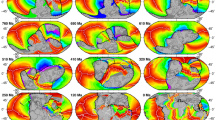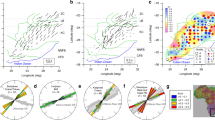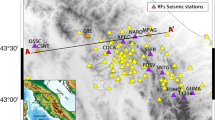Abstract
Arising from: D. R. Toomey, D. Jousselin, R. A. Dunn, W. S. D. Wilcock & R. S. Detrick Nature 446, 409–414 (2007)10.1038/nature05679; Toomey et al. reply
Mantle upwelling is generally assumed to be symmetric. Toomey et al.1 observe low seismic-wave velocity in off-axis mantle, and suggest that mantle upwelling is skewed, which has important implications for asthenospheric flow, ridge segmentation, crustal accretion, and volcanic, tectonic and hydrothermal vent activities along the ridge axis. However, we point out here that the mantle low-velocity zone (MLVZ) presented by Toomey et al.1 is not constrained by their data. We conclude that inferences pertaining to ridge segmentation and mantle flow are not reliable.
This is a preview of subscription content, access via your institution
Access options
Subscribe to this journal
Receive 51 print issues and online access
$199.00 per year
only $3.90 per issue
Buy this article
- Purchase on Springer Link
- Instant access to full article PDF
Prices may be subject to local taxes which are calculated during checkout

Similar content being viewed by others
References
Toomey, D. R., Jousselin, D., Dunn, R. A., Wilcock, W. S. D. & Detrick, R. S. Skew of mantle upwelling beneath the East Pacific Rise governs segmentation. Nature 446, 409–414 (2007)
Canales, J. P., Detrick, R. S., Toomey, D. R. & Wilcock, W. S. D. Segment-scale variations in the crustal structure of 150–300 kyr old fast spreading oceanic crust (East Pacific Rise, 8°15′N – 10°5′ N) from wide-angle seismic refraction profiles. Geophys. J. Int. 152, 766–794 (2003)
Barth, G. A. & Mutter, J. C. Variability in oceanic crustal thickness and structure: multichannel seismic reflection results from the northern East Pacific Rise. J. Geophys. Res. 101, 17951–17975 (1996)
Toomey, D. R., Solomon, S. C. & Purdy, G. M. Tomographic imaging of the shallow crustal structure of the East Pacific Rise at 9°30′. J. Geophys. Res. 99, 24135–24157 (1994)
Bazin, S. et al. Three-dimensional shallow crustal emplacement at the 9° 03′ N overlapping spreading center on the East Pacific Rise: correlations between magnetization and tomographic images. J. Geophys. Res. 106, 16101–16117 (2001)
Christeson, G. L., Purdy, G. M. & Fryer, G. J. Seismic constraints on shallow crustal emplacement processes at the fast spreading East Pacific Rise. J. Geophys. Res. 99, 17957–17973 (1994)
Seher, T. Seismic Structure of the Lucky Strike Segment at the Mid-Atlantic Ridge. Ph.D. thesis, IPG Paris (2008)
Neves, F. & Singh, S. C. Sensitivity study of seismic reflection/refraction data. Geophys. J. Int. 126, 470–476 (1996)
Shipp, R. M. & Singh, S. C. Two-dimensional full wavefield inversion of wide-aperture marine seismic data. Geophys. J. Int. 151, 324–344 (2002)
Harding, A. J. et al. The structure of young oceanic crust at 13° N on the East Pacific Rise from expanding spread profiles. J. Geophys. Res. 94, 12163–12196 (1989)
Macdonald, K. C., Fox, P. J. & Haymon, R. Thoughts on the significance of the East Pacific Rise “Undershoot” seismic results. Eos 88 (Fall Meet. Suppl.), abstr. T32B–02 (2007)
Author information
Authors and Affiliations
PowerPoint slides
Rights and permissions
About this article
Cite this article
Singh, S., Macdonald, K. Mantle skewness and ridge segmentation. Nature 458, E11–E12 (2009). https://doi.org/10.1038/nature07887
Received:
Accepted:
Issue Date:
DOI: https://doi.org/10.1038/nature07887
This article is cited by
-
Delayed response to mantle pull
Nature Geoscience (2016)
-
Toomey et al. reply
Nature (2009)
Comments
By submitting a comment you agree to abide by our Terms and Community Guidelines. If you find something abusive or that does not comply with our terms or guidelines please flag it as inappropriate.



